Which cities will have ups and downs in house prices
Editor’s note: This article is from the WeChat public account “Zimuliaofang” (ID: zimuliaofang ) , author: sub-wood.
Wen/Zimu
After the 2020 epidemic hit the global economy, the Fed across the ocean launched a new round of super QE cycle, and countries around the world followed suit.
Although Yang’s mother emphasized at the small meeting of the conference that the tone of “stable currency” should be run through the second half of the year, and the precise drip irrigation of small water should be more flexible and moderate, but the body is very honest.
Data shows that starting from March this year, the growth rate of M2 (money supply) has broken through the double digits, and has maintained a rapid growth for 6 consecutive months. You must know that the last double digit growth was 3 in 2017. Appeared at the beginning of the month of the property market regulation.
As the growth rate increases, the total amount of broad money is also rapidly gathering. As of August, the total amount of broad money in the country has reached 212.55 trillion.
You must know that in 2013, M2 was only 100 trillion, and in 2020 it will reach more than 200 trillion, which has doubled in less than 7 years, with an average growth rate of 15%.
This means that, except for the housing prices in the core areas of the first and second tiers and the leading stocks in the stock market, which can outperform the money printing machine, the rest is almost wiped out.
(Data source: Helue Research Institute)
Especially from January to June this year, it is even more terrifying. Half a yearTime M2 increased by 14.85 trillion yuan, which has exceeded the total of 13.07 trillion yuan in 2018-2019.
Yes, that familiar era is back.
Where did so much money go? What kind of impact will it have on everyone’s lives? Will the property market benefit from it? Which cities will have ups and downs in house prices?
These answers need to be understood.
Divided wealth
Last night, a reader joked in the WeChat group:
“My home is a state-owned enterprise compound. After the epidemic has passed, the streets are full of newly bought Mercedes-Benz BMWs without a brand. We have started a lot of new projects, and all the old projects that have not been settled before have been settled. It’s so easy to use X.”
Subsequently, it attracted a lot of complaints and complaints.
Because the Mercedes-Benz and BMW are driving here, but over there, there are a lot of people who are clearly not doing well, some crying and saying that their wages are not rising, and even those who lost their jobs and went to the Labor Arbitration Bureau to sue their old employers. .
The atmosphere of both ice and fire filled the sky.
According to the international algorithm, M2/GDP is used to measure financial deepening. At the end of 2018, China’s M2 reached 26.3 trillion U.S. dollars, accounting for 193% of GDP. Currency is already seriously over-issued. We have already The money printing machine slows down.
However, this year nobody expected that the emergence of the epidemic disrupted the currency rhythm.
Maintaining employment and stabilizing growth have become the number one task. In order to get past this stall, the most direct and effective way is to speed up the money printing machine again.
Unfortunately, we still don’t have a mechanism for helicopter money. Residents’ income is still mainly dependent on wages. Therefore, this part of the money can only be transferred from the bank to the company through credit, and then slowly from the company’s deposits. It becomes the deposit of residents.
Of course, fluid irrigation is a first-come-first-come, top-to-bottom conduction process. State-owned enterprises are generally ranked before private enterprises, business owners are ranked before employees, and social wealth is concentrated in the upper reaches, and then separated layer by layer, ordinary people can only receive the most basic wage income.
Scissors Difference Trend
Of course, there is a big gap between this time and history. Under the “precise drip irrigation” strategy, the authorities have strengthened supervision and built “canals” for the flow of living water.
Especially the property market has the highest repair rate, such as continuing to strengthen urban purchase restrictions, restricting residents’ house purchase leverage, setting three red lines for developers, and strict control at every level.
Indeed, the effect is significant. The real estate speculators have been suppressed under the Five Elements Mountain, but the endogenous driving force of the property market still exists. Under the currency transmission, after the residents’ wealth grows, they switch to buying houses.
Remarks: Proportion of increment=Increment of each loan entity/Total increment of each loan in 2019-2020
According to the latest report, among residents’ expenditures from 2019 to 2020, medium and long-term loans (mainly housing consumption) accounted for 33.75%. The purchasing power of real estate is accumulating, and the housing price foundation is continuously consolidated.
At this point, the M1-M2 golden scissors trend is obviously more convincing.
This picture is very classic and requires everyone to look carefully. The red line represents the year-on-year growth rate of M1, and the blue line represents the year-on-year growth rate of M2.
The red line in the same period is above the blue line (M1>M2), which proves that the market is full of liquidity, the property market is hot, and housing prices are rising; the blue line is above the red line in the same period (M1 If you carefully check several key areas in the figure, you will find that this fits closely with several historical housing price rise cycles. Let’s look at the recent part, probably fromSince the beginning of 2018, the year-on-year growth rate of M1 has fallen all the way, falling into the lower end of M2. It was not until the beginning of 2019 that it barely stopped the decline and rebounded. In the trend of 2019, March-May and November-December ushered in a rebound trend; in 2020, January due to the Spring Festival factor and the epidemic, hit 0, and then restart a new round of upward trend. If you often pay attention to the property market, you will find that the trend of M1 is very similar to the property market in major cities across the country. In particular, the market trend in Beijing is highly consistent. (Data source: Shell Research Institute) This is because Beijing is the most “golden” city in the country. Beijing has a large scale of enterprises and a developed financial industry. The “bank-enterprise” credit transmission mechanism is mature. The transfer path of “corporate deposits-residents deposits” is relatively fair and transparent. In other words, the central bank releases water and Beijing residents’ savings will start immediately. , Is a typical upstream player. From this, we understand that oversupply of currency is top-down, cities with strong ability to absorb money will benefit the most, and residents’ savings will grow the fastest, which will affect real estate transaction volume and house price growth. In short, the ability to attract money = real estate value = housing price potential. So besides Beijing, which other cities have the strongest ability to attract money? According to data from the Helue Research Institute, in the 60 major cities across the country, the incremental funds in domestic and foreign currency deposits in the past year reached 14.05 trillion yuan, accounting for 65.79% of the country’s 21.36 trillion yuan, and nearly 250 cities accounted for 34.21%. It can be seen that the capital accumulation effect of upstream cities has exceeded ordinary people’s imagination. Remarks: Proportion of increase = increase of each deposit subject/total increase of each deposit from 2019 to 2020 (data source: Helue Research Institute) The first echelon isGoing north to Shenzhen, funds increased by 4.43 trillion yuan within one year, taking 20% of the money. Among them, Beijing is the most obvious, surpassing the second place Shanghai by 4 trillion and surpassing Shenzhen twice. The accumulation and distribution of funds has allowed the wealth of residents in first-tier cities to grow rapidly. This also explains the fact that the real estate transactions in the three first-tier cities are booming in the first half of 2020. (Data source: Helue Research Institute) Followed by the second echelon, Hangzhou occupies the top spot, with a capital increase accounting for 4% of the country, and its ability to attract funds surpasses Guangzhou. Hangzhou has developed extremely fast in recent years. Driven by technological innovation, it has completed the layout of the city’s entire industrial chain. Some time ago, Hangzhou Ant Financial announced its launch to the world, with a valuation of nearly RMB 3 trillion. Over 5,000 people became rich overnight, which also triggered dramatic fluctuations in local housing prices. Secondly, Suzhou and Chengdu can stand in the second echelon, both of which are super new first-tier cities. Suzhou was forced to lie on the ground due to the large-scale regulation of the property market. Chengdu performed strongly in the property market in the first half of the year, and a number of real estate projects reappeared as a phenomenon of thousands of people robbing houses. The competition in the Yangtze River Delta has been around for some years. In the competition for wealth accumulation ability, the pattern has been very clear. Shanghai’s status as the big brother is still unchanged, Hangzhou is the new second-tier boss, followed by Suzhou, and finally Ningbo and Nanjing. Remarks: ★ are RMB deposit data, Urumqi and Baoding data are as of March (Data source: Helue Research Institute ) Moreover, it can be seen from the third echelon that wealth accumulation has obvious urban agglomeration effects. For example, in the Yangtze River Delta urban agglomeration, Nantong, next to Shanghai, is even more capable of attracting gold than Nanjing. Jiaxing, as a satellite city of Shanghai, has the same capacity of attracting gold as Hefei built by the power of Anhui Province. At the level of wealth flow, the Guangdong-Hong Kong-Macao Greater Bay Area is obviouslyCities that attract money










